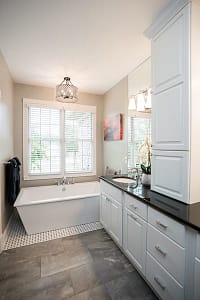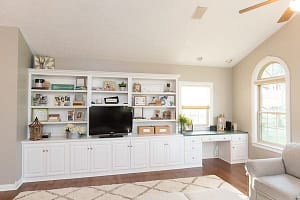Thinking “big” in a small space
When you have a small space in your home, it is best to design it with the vision of making it feel as large and spacious as possible. When you are trying to maximize this space, think “double duty” with everything that you can.
Making multiple uses of one item
Think of any items that you may have in your home that can be used multi-purposefully. Some examples may include an ottoman with storage space inside, sideboards with cabinets, or even furniture with storage functions. Simple additions such as these can create useful “hidden” space in your small room, to avoid taking up unnecessary space with extra items.

The less furniture, the better
When working in this smaller space of your home, the less furniture that you have, equals the better. When you have more items throughout the space, it creates the illusion that the space is much smaller, and feels much tighter and crammed together. If you limit yourself to only a few staple pieces in the room, it will create a larger, more spacious illusion.
Choice of Paint color
The color of paint that you choose for the small space plays a crucial role in how the space ends up feeling for you in your home. While white is the first and most obvious choice for a small room, due to its brightening hues and ability to create a larger illusion, it is not your only option!
Soft blonde- This color offers and adds warmth to any space, as it creates a comforting and home-like feeling. It can easily be paired with any neutral colored décor. A softly patterned rug would complete the look and offer a beautiful, yet simple, design for the comfort of your home.

Dark grey or coffee brown- The dark grey offers a more modern, chic, almost sophisticated vibe and feel, yet it is still cozy and comforting to any eye. The coffee brown takes more natural light, and creates shadowing throughout the room that can also cause it to feel more spacious and open.

Dark teal- Shadowing can actually be your friend when it comes to designing smaller spaces and rooms. Contrary to popular belief, painting a room with dark colors can hide the fact that it is so small. The darker colors create a perception of width and depth.
Minty green- This classic color gives a beachy and spring-time feel that you can enjoy all year round in your home. Pair this with any cream-colored furniture to make it stand out, open up, and brighten the room even more.
Soft yellow- A color that is fun and full of life, but not too obnoxious or blinding. It is perfect for those who want a little bit of color in their home, but do not want to take up larger rooms such as a living room or dining room. This color could also be perfect for a child’s nursery or bedroom, as it presents a playful and happy hue.
Super white- Though white may be a more basic color of choice, it is never a wrong one! Many whites have hues of blush pink of even olive green. However, the color super white, when painted across your walls, presents white in its purest and brightest form. When you paint your small space with a color as simple and luminous as this, natural light is reflected off of the walls and makes them recede, causing the small space to seem even larger– which was our whole goal in the first place!
Consider the feeling…
When spending time in this particular space of your home, consider how you want the room to feel. As you go about picking the wall colors, furniture, décor, and much more, ask yourself what kind of theme it is that you want to come to life in this space. What do you hope to gain from this space, and how do you intend to use it each day?
Lastly, do not be afraid to reach out for help. It can be challenging to make a design or vision come to life all on your own. Sometimes it is good to have a fresh pair of eyes to look at your work from a new perspective and help to offer friendly critique and assistance.
